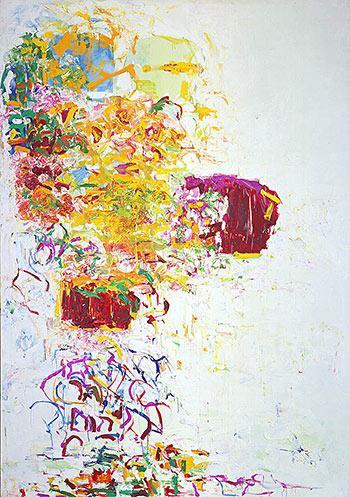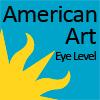On Saturday, April 27, American Art will be one of the over 240 museums around the world that will be hosting Slow Art Day. The event is free to the public. Jeff Gates took some time to talk with Slow Art Day's founder, Phil Terry, about the genesis of this event.

Joan Mitchell's SunflowerIII will be one of the artworks we will be looking at on Slow Art Day.
Eye Level: What is Slow Art and how did you come up with the idea for Slow Art Day?
Phil Terry: Slow Art Day is the annual event in more than 240 museums and galleries around the world with a simple mission: help more people discover the joy of looking at and loving art. This year participants show up on Saturday, April 27 at one of the participating museums and then look slowly, 5-10 minutes, at each of five pre-assigned works of art. Why focus on slow? When we look slowly at art we make discoveries. One of the most important discoveries we make is that we can see and experience art on our own. And that's exciting. It unlocks passion and creativity and helps to create more art fans. At Slow Art Day, we like to say that we are in the business of making more art fans: by helping people discover their own ability to look at and love art.
I came up with the idea while looking at Hans Hoffman's Fantasia for an hour during the 2008 Action/Abstraction exhibition at the Jewish Museum in New York. It was such a different experience to look at that one artwork for an hour that I decided that slow looking was the "secret" that would transform the visitor experience for the typical museumgoer like myself who was not an expert and didn't have the training in how to look.
EL: You don't work in a museum, so how have you gotten so many museums to participate in this yearly event?
PT: While you're right that I do not have a background in museum management, I do have a background in organizing online global movements. I did it at Harvard Business School when I built a global MBA conference on technology and the Internet in the 1990s. And I have gone on to do that for many cultural programs.
I'll add, however, the most important reason Slow Art Day has grown is because we've got a lot of help from a lot of people. You were an early adviser, for example. We also have an amazingly dedicated team of volunteers, including Caroline Wingate, who registers hosts from all over the world and gets them setup, and Dana Lemmer, who has built a college internship program as well as our global outreach database. Alie Cline, a student from the University of Texas, has done an amazing job building our Tumblr website to over 13,000 followers and now manages our whole social media team. Maggie Freeman, a student from Mills College, has been working to create our host support and best practice teams. In all, we also have more than 15 college interns (and we have more openings available!) and they have done a great job organizing and managing outreach and our social media channels.
Finally, I'll note that museums and galleries really love this simple concept and we make it easy (and free) for them to sign-up and host. There is growing awareness among museum directors, curators, and educators that Slow Art Day can help them improve their visitors' experience. After we started it in 2009 with 16 museums and galleries (including the Smithsonian American Art Museum), word of mouth really took off and it's grown from there.
EL: Yes, I was immediately attracted to Slow Art. As a museum professional, I'm surrounded by wonderful art and I work with it every day. However, I don't often get a chance to sit quietly and look. It was a pleasure I didn't know I was missing!
Phil, you're sort of a "Renaissance Man," an "amateur" in the original meaning of the word (amateur, meaning "lover of"). Tell us about your other passions.
PT: In 2005 I started the Reading Odyssey, a nonprofit dedicated to lifelong learning. Reading Odyssey has run many programs around the world with leading scholars including the Darwin 150th Anniversary program (commemorating the 150th anniversary of the publication of On the Origin of Species) and Marathon2500, reflecting on the 2,500 year anniversary of the Battle of Marathon. Both these programs and others have involved thousands of people at locations all over the world and lots of social media support and activism. My "day job" is running Creative Good, an Internet consulting firm focused on customer experience.
The common philosophical thread among all these projects is that I really am interested in creating environments where people learn they are capable of change and development, whether they are reading a classic in the Reading Odyssey, looking at great art in Slow Art Day, or listening to their customers or their peers at Creative Good. I'm interested in that moment when people realize they can have a more active, considered experience leading a company, looking at art, or reading a book. I also am longtime yoga practitioner, which has influenced me in a myriad of ways. And I love theater and film—and I quite enjoy watching really good movies again and again (I suppose you could say that I'm like a kid that way).
EL: What artwork from American Art's collection would you like to sit in front of and take in nice and slow?
PT: Edward Hopper's Cape Cod Morning is such a beautiful painting. I love the light. I love the woman looking out the window. I'd love to really sit and take in the colors and emotions of this painting and consider the question of what exactly it is that woman is looking at. In contemporary parlance, she's leaning in. What is she leaning towards?

